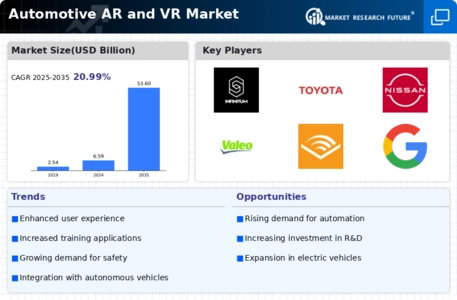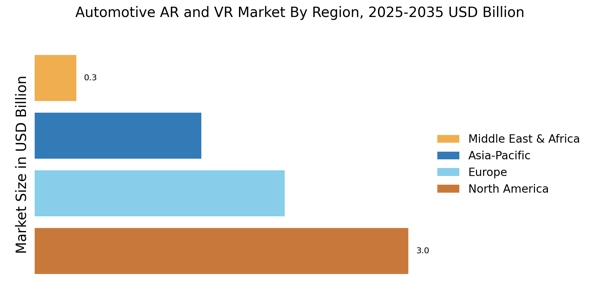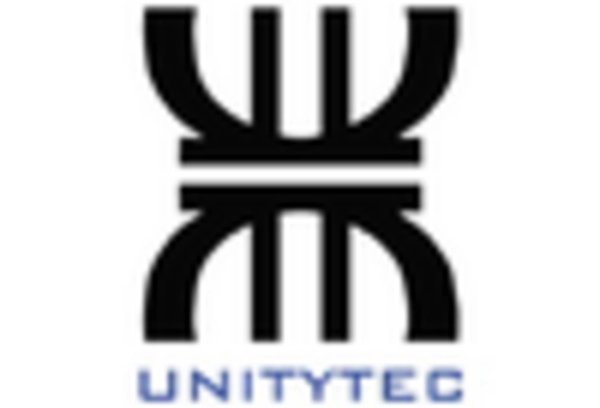Advancements in AR and VR Technology
Technological advancements play a pivotal role in shaping the Automotive AR and VR Market. Innovations in hardware and software are enabling more sophisticated applications, such as real-time navigation overlays and virtual maintenance assistance. The development of lightweight, high-resolution displays and improved processing power allows for more realistic simulations and interactions. Furthermore, the integration of artificial intelligence with AR and VR technologies enhances user experiences by providing personalized content and recommendations. As these technologies continue to evolve, they are likely to become more accessible and affordable for automotive manufacturers, thereby accelerating their adoption. This trend suggests that the Automotive AR and VR Market will continue to expand as companies leverage cutting-edge technology to improve customer experiences and operational efficiencies.
Growing Focus on Training and Simulation
The Automotive AR and VR Market is increasingly recognized for its potential in training and simulation applications. Automotive companies are utilizing AR and VR technologies to train employees in a safe and controlled environment, reducing the risks associated with traditional training methods. For instance, virtual reality simulations allow technicians to practice repairs and maintenance procedures without the need for physical vehicles. This approach not only enhances learning outcomes but also reduces training costs. Industry reports indicate that the use of AR and VR for training purposes is expected to grow at a compound annual growth rate of over 30% in the coming years. This growing focus on training and simulation underscores the value of AR and VR technologies in improving workforce skills and operational efficiency within the automotive sector.
Increased Demand for Immersive Experiences
The Automotive AR and VR Market is witnessing a surge in demand for immersive experiences among consumers. As technology advances, customers increasingly seek interactive and engaging ways to experience vehicles. This trend is reflected in the growing adoption of AR and VR technologies by automotive manufacturers, who utilize these tools for virtual showrooms and test drives. According to recent data, the market for AR and VR in automotive applications is projected to reach USD 20 billion by 2026, indicating a robust growth trajectory. This demand is driven by the desire for enhanced customer engagement and the need for innovative marketing strategies that resonate with tech-savvy consumers. As a result, automotive companies are investing heavily in AR and VR solutions to differentiate themselves in a competitive landscape.
Integration with Connected Vehicle Technologies
The integration of AR and VR technologies with connected vehicle systems is a significant driver for the Automotive AR and VR Market. As vehicles become increasingly connected, the potential for AR and VR applications expands. For example, augmented reality can provide real-time data overlays on the windshield, enhancing navigation and safety. Additionally, VR can be used for remote diagnostics and troubleshooting, allowing technicians to visualize issues without being physically present. This synergy between connected technologies and AR/VR applications is likely to enhance user experiences and improve vehicle performance. As the automotive industry continues to embrace connectivity, the demand for AR and VR solutions that complement these technologies is expected to rise, further propelling the growth of the Automotive AR and VR Market.
Rising Consumer Expectations for Personalization
Consumer expectations for personalization are driving the Automotive AR and VR Market to new heights. Today's consumers seek tailored experiences that cater to their individual preferences and needs. AR and VR technologies enable automotive manufacturers to offer personalized vehicle configurations and interactive experiences that resonate with buyers. For instance, virtual reality can allow customers to customize vehicle features and visualize their choices in real-time. This level of personalization not only enhances customer satisfaction but also fosters brand loyalty. Market analysis suggests that companies that leverage AR and VR for personalized experiences are likely to see increased sales and customer retention. As consumer expectations continue to evolve, the Automotive AR and VR Market must adapt to meet these demands, ensuring that personalization remains at the forefront of innovation.


















Leave a Comment